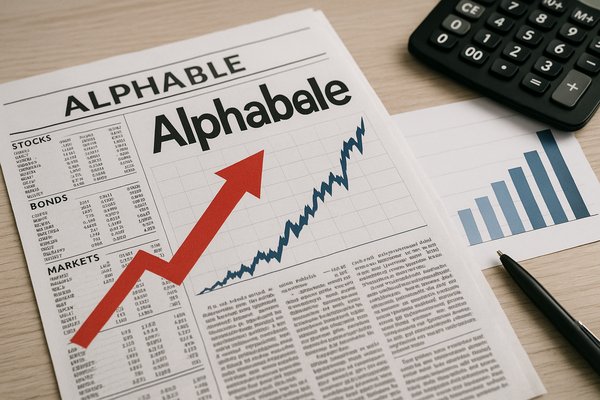
Alphabet Q3 strength lifts AI ad momentum. Evercore ISI raised its price target on Alphabet to $325 from $300 and kept an Outperform rating after Q3 results that beat expectations across key metrics. The move matters now because broker upgrades and higher price targets can reprice large-cap tech pockets in the near term and shift capital flows across US and global indices. In the short term, investors react to analyst revisions and quarterly beats; in the long term, persistent AI-driven ad demand and cloud compute spending could underpin revenue growth. For the US, Europe and Asia, stronger ad performance at Alphabet supports digital ad ecosystems; for emerging markets, ad monetization lag means slower revenue capture. Compare this to recent PT moves: Jefferies raised Nvidia to $240 from $220 on compute demand, while Evercore trimmed Meta to $875 from $930 on higher investment plans. The timing is notable: analyst updates, AI product launches and corporate results clustered in early November have compressed news flow and sharpened investor focus.
Alphabet’s results and analyst momentum
Evercore’s upgrade to a $325 target reflects Q3 strength. The firm maintained an Outperform rating on Alphabet after the quarter. The upgrade follows multiple positive data points in the quarter that pushed analysts to revise assumptions on ad demand and cloud spend.
Evercore lifted its target from $300 to $325 on October 30. That move joins a spate of price-target revisions across large cap names this week: Jefferies boosted Nvidia to $240 while Evercore trimmed Meta to $875. Analyst activity matters because Alphabet is a major weight in US indices and passive funds, so a cluster of upgrades can change passive flows and ETF rebalancing in the near term.
Globally, Alphabet’s ad platform benefits from stronger search volumes in North America and Asia. However, regional monetization still varies: Western ad CPMs remain higher, while emerging market CPMs lag. Short-term, higher analyst targets tend to lift sentiment. Longer-term, revenue growth will depend on sustained advertiser spend into AI-enabled formats and continued cloud adoption.
AI compute and chip demand — Nvidia and ecosystem signals
Jefferies raised Nvidia’s price target to $240 from $220, citing sustained AI compute demand and clearer visibility into order pipelines. That upgrade signals rising underlying demand for hardware that powers AI models and services.
Several product and partnership headlines reinforce this trend. Nvidia also expanded activity in India through a $2 billion deep-tech alliance to mentor startups. OpenAI released Sora to Android in multiple countries including the US, Canada, Japan, South Korea, Taiwan, Thailand and Vietnam — geographic expansion that increases demand for inference capacity.
These developments matter now because they tighten short-term capacity planning for datacenter operators and chip suppliers. Jefferies’ PT rise is a concrete market indicator: +$20 on Nvidia’s target in a single revision. That flows through to related hardware and cloud names that host inferencing workloads.
Adtech and platform reactions: DoubleVerify, Meta and Pinterest
Ad verification and platform economics are at the center of recent moves. DoubleVerify (NYSE: DV) launched DV AI Verification™ on November 4, a product designed to identify and manage AI agent interactions and reduce low-quality AI-generated ad inventory.
At the same time, major platforms faced mixed investor responses. Evercore cut Meta’s price target to $875 from $930 while keeping an Outperform rating, citing higher near-term investment spending plans that pressure margins. Pinterest suffered a sharp market reaction: shares plunged about 20% after a Q3 earnings miss and weak guidance.
Those numbers matter for advertisers and adtech vendors. A 20% drop at Pinterest underscores how sensitive ad-dependent models are to revenue misses. DV’s product launch is quantifiable proof that buyers and sellers are already adjusting operations to an AI-first creative supply chain. Advertisers and measurement vendors will likely reallocate budgets toward verified placements until AI-generated quality stabilizes.
Gaming and platform content — Roblox, Netflix, Reddit and market flows
Content platforms showed divergent responses to Q3 releases. Roblox (RBLX) posted strong bookings and revenue beats, driving massive gains in daily active users, but the stock dropped more than 15% after management warned of widening net losses and margin pressure. Macquarie maintained an Outperform on Roblox even as volatility hit shares.
Netflix and ServiceNow announced share splits in recent days — two large-cap names taking steps to improve retail accessibility. Separately, market chatter about Netflix licensing video podcasts sparked a 27% surge in iHeartMedia stock after reports of talks with Netflix. Those moves show how content partnerships and corporate actions can create outsized single-stock moves: +27% for iHeartMedia, >15% drawdown for Roblox.
Reddit also posted Q3 strength, with analysts highlighting rising user engagement as a driver for ad revenue growth. These quantifiable shifts in share prices and user metrics are already influencing sector rotations as investors seek durable monetization paths for community and content platforms.
Connectivity, infrastructure and the broadband outlook
Broadband fundamentals added pressure to communications incumbents. Charter reported fiscal Q3 revenue of $13.7 billion on October 31, a 0.9% year-over-year decline driven by weaker residential video and advertising sales. That single-quarter revenue drop illustrates the headwinds operators face as video bundles compress ARPU gains.
Analysts reacted: Oppenheimer downgraded Comcast (CMCSA) and Charter (CHTR) from Outperform to Perform, citing worsening broadband trends and structural headwinds likely to weigh on growth over the next five years. Global infrastructure moves continue alongside those concerns: Globalstar announced the installation of eight new six-meter C-3 antennas across Brazil, expanding ground-station coverage.
In short, connectivity and infrastructure headlines contain concrete numbers that traders and portfolio managers use to recalibrate exposure: $13.7 billion in quarterly revenue for Charter, an Oppenheimer downgrade across two carriers, and eight new antennas for Globalstar in Brazil.
Compliance note: This commentary is informational only. It cites reported results, analyst ratings and market moves. It does not offer investment advice or recommendations.












